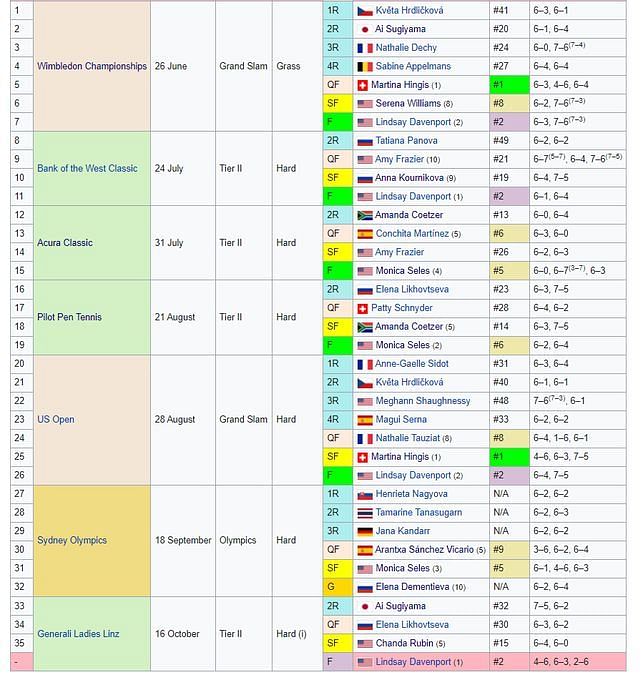
20 years ago on this day, Venus Williams scripted history with her rise to the top of the WTA rankings

Twenty years ago on February 25, 2002, Venus Williams became the first African-American player -- male or female -- to be crowned World No. 1. Althea Gibson, who was one of the best players of the 1950s and broke a lot of racial barriers during her time, would've had this honor before Williams. However, back then there were no official rankings.
Williams' rise to the top was slow and steady and she had to overcome plenty of obstacles, both on and off the court. Out of the thousands who have played this sport, only a few have had the opportunity to reign as World No. 1. So let's take a look at how Venus Williams managed to do it.
Venus Williams' journey to the top of the rankings

Williams made her WTA tour debut in October 1994 at the Bank of the West Classic. She made a winning start to her career, defeating Shaun Stafford in straight sets. She lost in the next round to World No. 2 Arantxa Sanchez Vicario.
Over the next two years, she competed in eight tournaments, with her best result being a quarter-final appearance at the Bank of the West Classic in 1995. Williams made her breakthrough in 1997. She made the final of the US Open, losing to Martina Hingis. The American ended the year ranked No. 22, having been ranked outside the top 200 at the end of the previous season.
In February 1998, Williams won her maiden career title at the IGA Tennis Classic. The following month, she won the biggest title of her career at the Miami Open, defeating World No. 1 Hingis en route.
The title propelled the American into the top 10 of the rankings. Although she didn't make the final at any of the Grand Slams in singles that year, she reached at least the quarterfinals in all of them. She also won the Australian Open and the French Open in mixed doubles with Justin Gimelstob.
Williams ended the 1998 season ranked No. 5, having won three titles from seven finals. Her career trajectory was moving upwards at a remarkable pace. In 1999, she won six titles from 10 finals to finish the year ranked No. 3.
While Grand Slam success eluded Venus Williams in singles, younger sister Serena Williams made her breakthrough by winning the 1999 US Open. The siblings won the French Open and the US Open in the women's doubles that year as well.
Williams' start to the 2000 season wasn't ideal, as she missed the first few months of the year due to injury. She made her comeback during the clay season, with quarter-final appearances at Roland Garros and the Hamburg Open being her best results.
The American wasn't deterred by her slow start to the year. She quickly found her groove to emerge as the most dominant player for the rest of the season, which included a 35-match winning streak.
During the unbeaten run, she won six titles, including her maiden Grand Slam in singles at Wimbledon, along with the doubles title. She followed it up with a victory at the US Open and a gold medal in singles and doubles at the Sydney Olympics.
Lindsay Davenport finally put an end to Williams' winning ways in the final of the Linz Open. The American once again ended the year ranked No. 3 in the world.
Venus Williams continued her run of good form in 2001. At the Australian Open, she reached the semifinals for the first time in singles. Along with sister Serena, she won the women's doubles title in Melbourne to complete a career Golden Slam in the discipline.
Later on, she successfully defended her Wimbledon and US Open titles, defeating Justine Henin and Serena Williams respectively in the finals. For the third straight year, she ended the season ranked No. 3.
Venus Williams' years of consistency finally catapulted her to the top of the rankings

Venus Williams began the 2002 season on a triumphant note by winning the Gold Coast International. At the Australian Open, she lost in the quarterfinals to Monica Seles.
At the start of February, she reached a career-high ranking of No. 2. She won two titles over the next couple of weeks, which gave her enough points to rise to the top of the rankings. On February 25, 2002, Williams replaced Jennifer Capriati as World No. 1, becoming the 11th woman to claim the top ranking.
She remained at the top for three weeks before Capriati replaced her once again. The back and forth between them continued until July, when Serena Williams ascended to the top for the first time. She replaced her sister as World No. 1 on July 8, 2002, following her victory at Wimbledon, and remained at the top of the rankings for more than a year.
At just 11 weeks, Venus Williams' reign at the top was rather short-lived. She had her chances to regain the top spot in 2002 and 2003, reaching four consecutive Grand Slam finals, but lost to her younger sister in each of them.
While she never claimed the No. 1 ranking again, Williams was a steady presence in the top 10 for many years. Even when she fell out of that bracket due to injuries and health issues, she often found her way back. Along with her sister, she also became World No. 1 in doubles in 2010 after winning the French Open.
Venus Williams was the top-ranked player in an insanely competitive era of women's tennis. Getting to the top when Serena Williams, Martina Hingis, Justine Henin and Lindsay Davenport, among others, were in their prime is a worthy achievement, and one which she should be celebrated for.



